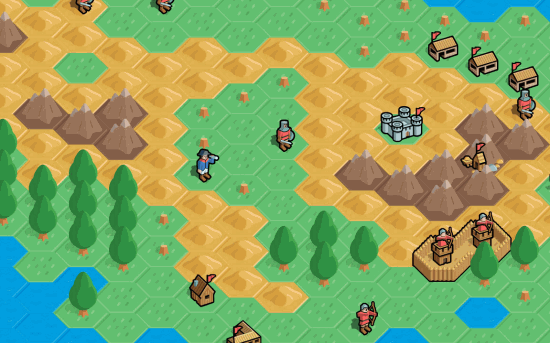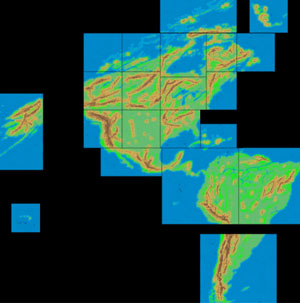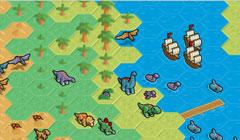Based in Auckland, New Zealand, indie developer David Colquohun started running his MMORTS game
Ironfell in 2012. In August 2013, he had to close it down because it was losing too much money. The game had accumulated losses of $17,300, and that's before calculating in payment for his time.

Just one month later, in September 2013,
Ironfell restarted. The new version had
a number of changes to make it more active and reduce the number of empty realms. He's also published a log of his
profit & loss as an income of $7,000 and outgoings of $23,000. It's a bit suggestive of the old joke: "How do you make a small fortune on the internet? Answer: Start with a large fortune." In this article, we’ll take a close look at the finances. Examples of published figures like this are rare, so it's good information for anyone considering running their own game.
The Game
Ironfell is a beautiful looking, multiplayer, real-time strategy game that currently has 120 realms and 582 players. It can be played either as a Flash browser-game, or downloaded for Windows, Android or Mac OS X. There will also be a fully native iOS version, though it’s not ready yet. Its graphics are pixel graphics on a hex grid and they look really nice.

The game starts by throwing the player back in time to the age of dinosaurs, from which he or she must carve out an empire. Its genre is a mixture of explore and encounter, resource-gathering and real time strategy. It's a little like the original
Warcraft PC game except there are 140 different unit types in
Ironfell, plus time machines and dinosaurs.
Losing Money
So why did the game lose so much money? Well, on the numbers page Colquohun shows fixed costs (ads of $4,450, artwork at $9,751, and servers). The Las Vegas-based servers are listed at almost $8,900 -- I'm not sure if those are a one-off fixed cost or an ongoing variable figure that includes bandwidth. The same page also shows the daily income, which comes from donations or players buying in-game resources. In the first eight days after the game restarted, the Daily Average Users (DAU) shot up from zero to just over 100, and exceeded 150 on three occasions. Colquohun's revenue at that time averaged just under $200 per day. So in theory he should have been moving into profitability in less than three months. The big questions surround the churn rate and whether this revenue level is sustainable.
Calculating the Churn Rate
Churn rate is
a measure of attrition. It's a useful indication of how many players are happy with the game. The lower the churn rate, the fewer players are leaving and the greater the profitability will be. There's an old adage that it costs five times as much to attract new customers as it does to retain them. While it probably varies by sector and industry and five times may seem arbitrary, the principle remains sound. Happy customers tell others and bring in new players. In the first eight days after the game restarted Colquohun gained 504 players, but only an average of 130 players were in action each day. In this type of game, where you need to play and then come back again after the resources (trees) have regrown, missing a day suggests that you've dropped out. On the first day, Sept. 20, Colquohun had 49 new players and 49 DAU. On the second day, there were 122 new players, giving a total player base of 171, but there were 156 DAU, suggesting that 15 had dropped out. In the first eight days there were 504 new players, but only 128 were playing on the eighth day. That means only one in four was still playing -- that's an excessively high churn rate by any account. Further complicating its profitability, the game is based on the freemium model, meaning playing the game is completely free, but players can buy resources to improve their position. In the case of
Ironfell, resources range from $1 bundles up to the $50 Queen's ransom. So the real question is, what percentage of players are spending money? In most games it's a small percentage, maybe 5 percent. In all cases, more players equal more revenue.
Conclusions

Looking at the game's blog, the developer is putting in a lot of time bug fixing, tweaking the game parameters and working on a series of very ambitious extensions (flight, space!). The game is already pretty massive, which might help explain the high churn rate -- It's not easy to grasp how big it is or how exactly you fit in, leaving too much uncertainty and a lack of foreseeable goals. My suggestion would be start asking players about their initial impressions of the game to find out what they dislike or don't understand about it and address those issues first. Hopefully, that could put a stop to the 75 percent hemorrhage rate and improve the bottom line.
Monetization
In addition to the resource buy-ins, some players have suggested vanity purchases such as titles, displayable coats of arms, etc. And what about the merchandising? It not only brings in revenue, it’s also good advertising. And I’d bet those pixel graphics would look great on a T-Shirt or mug.
 Just one month later, in September 2013, Ironfell restarted. The new version had a number of changes to make it more active and reduce the number of empty realms. He's also published a log of his profit & loss as an income of $7,000 and outgoings of $23,000. It's a bit suggestive of the old joke: "How do you make a small fortune on the internet? Answer: Start with a large fortune." In this article, we’ll take a close look at the finances. Examples of published figures like this are rare, so it's good information for anyone considering running their own game.
Just one month later, in September 2013, Ironfell restarted. The new version had a number of changes to make it more active and reduce the number of empty realms. He's also published a log of his profit & loss as an income of $7,000 and outgoings of $23,000. It's a bit suggestive of the old joke: "How do you make a small fortune on the internet? Answer: Start with a large fortune." In this article, we’ll take a close look at the finances. Examples of published figures like this are rare, so it's good information for anyone considering running their own game.
 The game starts by throwing the player back in time to the age of dinosaurs, from which he or she must carve out an empire. Its genre is a mixture of explore and encounter, resource-gathering and real time strategy. It's a little like the original Warcraft PC game except there are 140 different unit types in Ironfell, plus time machines and dinosaurs.
The game starts by throwing the player back in time to the age of dinosaurs, from which he or she must carve out an empire. Its genre is a mixture of explore and encounter, resource-gathering and real time strategy. It's a little like the original Warcraft PC game except there are 140 different unit types in Ironfell, plus time machines and dinosaurs.
 Looking at the game's blog, the developer is putting in a lot of time bug fixing, tweaking the game parameters and working on a series of very ambitious extensions (flight, space!). The game is already pretty massive, which might help explain the high churn rate -- It's not easy to grasp how big it is or how exactly you fit in, leaving too much uncertainty and a lack of foreseeable goals. My suggestion would be start asking players about their initial impressions of the game to find out what they dislike or don't understand about it and address those issues first. Hopefully, that could put a stop to the 75 percent hemorrhage rate and improve the bottom line.
Looking at the game's blog, the developer is putting in a lot of time bug fixing, tweaking the game parameters and working on a series of very ambitious extensions (flight, space!). The game is already pretty massive, which might help explain the high churn rate -- It's not easy to grasp how big it is or how exactly you fit in, leaving too much uncertainty and a lack of foreseeable goals. My suggestion would be start asking players about their initial impressions of the game to find out what they dislike or don't understand about it and address those issues first. Hopefully, that could put a stop to the 75 percent hemorrhage rate and improve the bottom line.

![Go to article States Throw Money At Game Studios [DiceTV]](/binaries/small/content/gallery/dice/insights/2012/03/cat_032012.jpg)

